Instagram has announced in April 2019 that they started their test of hiding Likes on the platform for some users in Australia, New Zealand, Brasil, etc. Now they have expanded the coverage of the test to a small portion of accounts from all around the world. The tested users can still access the number of Likes and Views of their own photos and videos, but not of the others on their Feed.
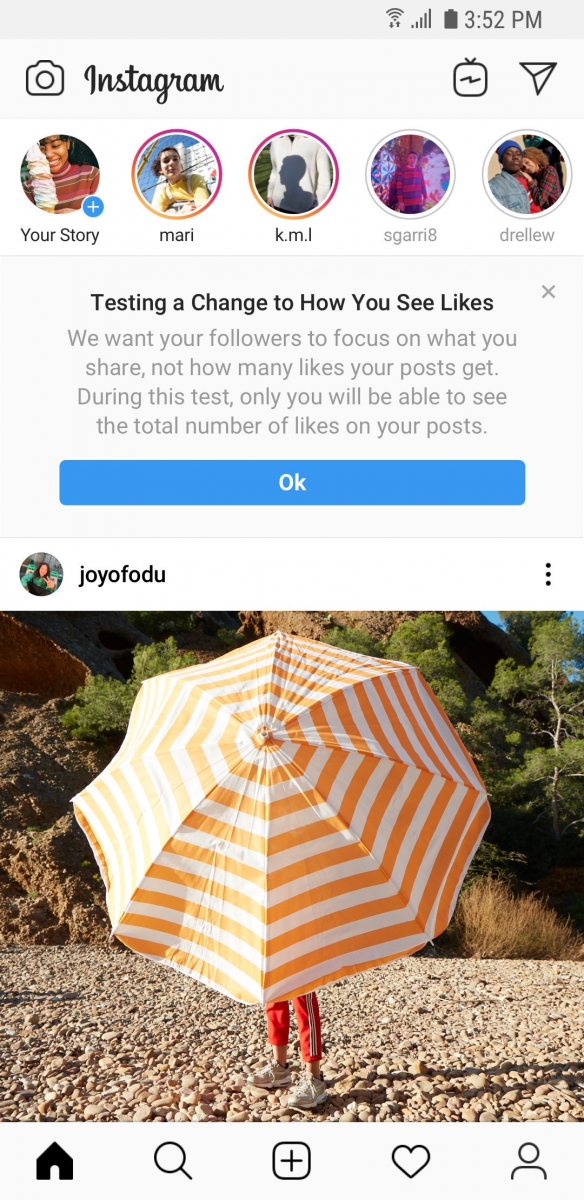
Source: Instagram
According to the CEO of Instagram, Adam Mosseri, the purpose of hiding Likes on Instagram is to remove the pressure of comparing how many Likes one receives to others. Users will share more realistic content, instead of falling under the pressure to share what they think their followers “Like”. This might be true for everyday users, but how will it affect the KOLs and marketers who rely on the number of Likes as an engagement metric?
Who are the stakeholders and how Instagram hiding Likes affects them?
KOLs
Japan, Italy, Ireland, Brazil, and Australia were the first regions in which the new change was tested. HypeAuditor then studied 154K Instagram influencers on these regions, comparing the results from the UK where the test is inactive.
To summarize, the impact of this new change varies from tiers to tiers of KOLs, and from regions to regions. Brazilian KOLs suffered the most regardless of the tier. Meanwhile, Japanese KOLs are the least affected, even recording an increase in the number of “Likes”. If focusing on the influencer tiers, Instagram hiding likes has not brought a lot of impact to Celebrities.
For Nano-influencers (1K-5K followers), Likes in most of the regions, but not in Japan and Ireland, has significantly dropped.
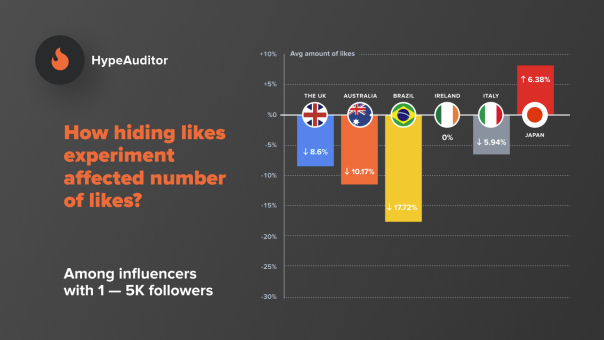
Source: Social Media Today from HypeAuditor
For Micro-influencers (5-20K followers), the impact is more definitive. All the studied regions had a decrease in “Likes”.
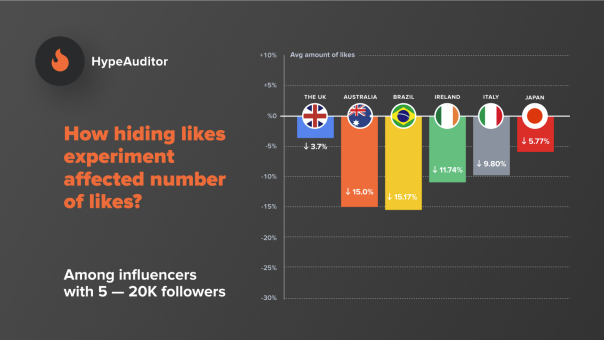
Source: Social Media Today from HypeAuditor
For Macro-influencers (20K-100K followers), all regions recorded a decrease in “Likes”, in which Brazilian KOLs being affected the most.
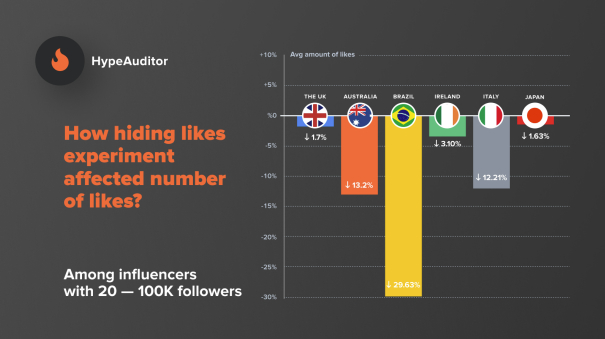
Source: Social Media Today from HypeAuditor
Celebrities (100K-1M+ followers) in Japan has a significant boost in “Likes”, which is contrary to the results in other countries.
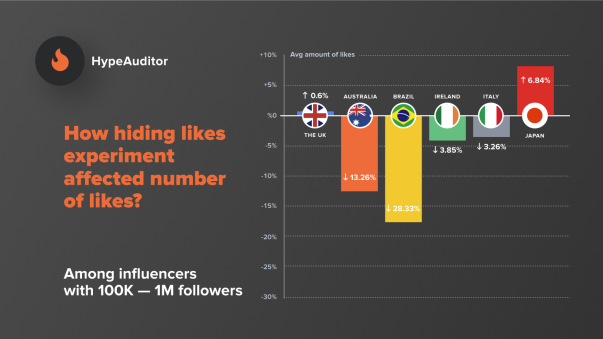
Source: Social Media Today from HypeAuditor
Although this study is not definitive, we could still observe a reduction of overall engagement in all regions. Hence, if you observed a drop in engagement as an influencer, there is no need to worry yet. Most likely, other influencers will also experience the same situation once Instagram hiding Likes is official for everyone. It might even help your content and creativity flourish as brands would reasonably focus more on the content created, not on the figures. This could also help eliminate KOLs that buy fake Likes, creating a fairer competition.
Opinions from our experts
Business strategy perspective-Albin Lix, Managing Director – Founder in Digital Business Lab
Facebook will soon rely on Instagram. Facebook’s ad business has been growing rapidly for years, and that has helped it become one of the world’s most valuable companies. But it has also been warning for two years that its revenue growth would start to slow. When that happens, Instagram will have to drive the next phase of growth. Instagram could drive 70% of the company’s new revenue vs 15% for the last quarter.
Facebook will soon rely on Instagram for the majority of its ad revenue growth, Kurt Wagner and Rani Molla, Vox
The Revolution of Instagram Hiding Likes is a strong signal sent by Facebook to protect the original core asset of Instagram – Authentic & Creative content! By testing and gradually removing likes, Instagram is influencing the way users are thinking and producing content to preserve the end-user experience.
Main risk: this evolution could drive significant frustration to the massive part of the Instagram audience addict to Like racing.
Main opportunity: Instagram preserves and pushes end users to share the content they personally like first which should help to maintain a better level of creativity, retain MAU (monthly active users) and consequently protect future advertising revenue in the long term.
Social media perspective-Xavier Schillinger, Director of Operations – Partner in Digital Business Lab
The results of the study are not surprising, the social aspect of “liking”, a form of gamification, is crucial in the experience of users across all social media. This type of reward, potentially extreme, is answering to the very natural human need of recognition – also found in video games. In this context, we must now anticipate the future of this “social media gamification”. Will users continue to be as active now that social media usage is a daily habit? Will other forms of interactions arise (comments)?
For marketers, brands & agencies alike, there’s an immediate need to re-think about the golden “engagement rate”. Other KPIs should be taken into consideration, from reach to views, and brought to light depending on the objectives of the social media activities.
Video creator perspective-Savina Suresh, Head of Video Production
Content quality is more crucial than ever
Removing the number of likes will definitely impact user behavior and content consumption. But in terms of video content, Instagram videos only account for 54% of the influencer marketing content as opposed to 73% from Instagram stories! Meaning that Likes has never been the most important metric for influencer video marketing. It’s always more about the content itself than the Likes and Comments on each piece of content.
Quality content that is relatable to the users, capturing their attention, making the user stop scrolling and taking a pause to pay attention to a piece of content is the most important measurement. Users will still consume content that resonates with them irrespective of whether they can see the likes or not.
User attention metrics might be the new focus
It can also help brands and marketers to now focus on user attention metrics when it comes to videos. Most users just LIKE random video posts, either judging by the thumbnail or the caption. Users clicking the Like button is not equivalent to having watched the full video, with audio on, and understood the communicated message. These are all important for viewers to fully grasp the message, then to decide whether they “like” it or not.
Sometimes people don’t hit the like button on a particular piece of content fearing the opinion of their friends/follower/social circles. Vice versa, sometimes they like it as they have seen their friends doing it. With Instagram hiding likes, users might break away from the façade on social media and interact in a more genuine way! This might diversely affect the way brands interpret the reactions of their audiences to a certain piece of content. It can really be a game-changer in the sense of opening new avenues for content creators and brands to explore. They might discover new topics that resonate with their audience then transferring these to their feeds and stories. Consequently, it drives brands to create more content that actually captures the attention of the users in its full essence.
Project lead prospective-Frances Tseng, Account Manager
Challenge for marketers when scouting for influencers
Instagram hiding likes potentially creates a challenge for marketers when searching for the right content creators to collaborate with. This public metric has been one of the most important gauges when evaluating the engagement rate of a content creator. In other words, the “Influence” of an Instagram KOL. But fear not, one way to evaluate the KOLs’ performance is through influencer marketing platforms. These platforms usually have access to influencers’ comprehensive data that are necessary for marketers to choose the right partner.
Content is still the key
As Mark Zuckerberg stated, “We want people to be less interested in how many likes a post gets, and focus more on connecting with other people”. Once this metric of “success” is removed, influencers are motivated to produce authentic content to connect with their audience. This means we put more emphasis than ever in the KOL’s content when evaluating their compatibility with the campaign.
Opinions from our partner and client
Technology partner perspective- Selena Priya, APAC Content Marketing Lead, Meltwater
In the longest time, the presence of Instagram bots has put the authenticity of likes and followers count into question. Given our position as an industry leader in social media, we have advocated for the use of other metrics that are better indicators of success as compared to vanity metrics.
Today, as Instagram removes likes, our customers are well-prepared to confront this challenge. Alternative metrics will be imperative in helping them to measure the success of Influencer Marketing campaigns moving forward. As tech giants Facebook and Google become more accountable to consumers, advertisers and marketers have to redefine the way they measure success and remain agile to rise ahead of this shift.
Client partner perspective – Cameron Mayo, Manager – Brand & Marketing Communications APAC– Infiniti Motor Company
This is an interesting change and not one that was necessarily expected given the careful dance between monetizing a platform, ensuring a healthy revenue stream, and keeping it as a true place where creators feel they can express themselves authentically. In all, I think this is a good move to maintain the integrity of the platform by making users feel comfortable in sharing good content.
Driven by this major change in engagement metric, for sure we will look at different success measurements. Beyond that, and something that has held true for all paid partnerships, brands will have to collectively take a deep breath and say that it’s okay to not dwell on numeric values, such as Likes, in these content partnerships. We will all have to dig deeper and see where our work on the platform and with KOLs has a more organic and believable connection, which is beyond the number of Likes.
If you are interested to carry out influencer marketing, contact us!


